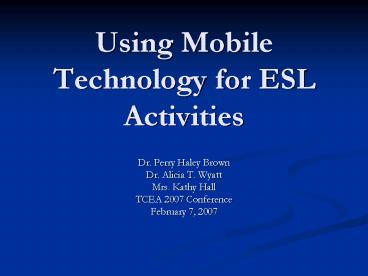Using Mobile Technology for ESL Activities - PowerPoint PPT Presentation
1 / 30
Title:
Using Mobile Technology for ESL Activities
Description:
Following a discussion concerning the experience the students will. Talk and discuss. Make lists. Expressive Language. Free discussion. Make contributions ... – PowerPoint PPT presentation
Number of Views:48
Avg rating:3.0/5.0
Title: Using Mobile Technology for ESL Activities
1
Using Mobile Technology for ESL Activities
- Dr. Perry Haley Brown
- Dr. Alicia T. Wyatt
- Mrs. Kathy Hall
- TCEA 2007 Conference
- February 7, 2007
2
Language Acquisition
- Second language acquisition is a dynamic,
creative innate process.
3
Needs
- Comprehensible input
- Visuals
- Manipulatives
- Emphasis on key words
- Modeling
- Hands-on activities
- Low affective filter
- Use of patterned language
- Repetitive and predictable
- Cooperative teamwork
- Natural interactions
4
Language Experience Approach
- Expands vocabulary
- Provides successful reading experience
- Receptive Language
- Stages
- Comprehension Phrases
- Single words Paragraphs
5
LEA
- Following a discussion concerning the experience
the students will - Talk and discuss
- Make lists
6
Expressive Language
- Free discussion
- Make contributions
- The teacher will record the responses exactly as
they are given - Spell words correctly, but dont change the
contributors sentence structure - Read aloud
7
BICS and CALPS
- Basic Interpersonal Communication Skills
- Cognitive Academic Language Proficiency
- If you can say it then you can write it.
- If you can write it then you can read it.
8
Develop Oral Language Capacity
- Read aloud
- Encourage choral reading
- Place LEA stories where students can read them
- Encourage use of new words in classroom
interactions
9
Develop Written Language Capacity
- Encourage students to mark (highlight) the words
they know - Place words in word boxes or banks
- Classify words
10
Engaging Pre-service Teachers with ESL Students
- Goals
- Engage pre-service students with ELLs
- Authentic LEA experience
- Technology integration
- Digital images/video
- Recorded sound
- Transcribed text
11
Engaging Pre-service Teachers with ESL Students
- Process
- Based on the philosophy of say, write, read
- Trained McM students to use the technology
- Tablet computer
- Digital camera
- Brought K-ELLs on campus
- Three different activities
12
Technology Used
- Tablet Computer
- Portable (small and lightweight)
- Easy to use
- Built in microphone and speakers
- Digital Camera
- Can have sound recording and video capacity
13
Software Used
- Software we used
- PowerPoint
- Websites
- Sound Recording (Audacity)
- Additional Software
- Photostory 3
- MovieMaker 2
14
Three activities
- Digital Storytelling
- Using multimedia language websites
- Listening to a patterned language story,
recording responsive reading
15
Activity 1 Digital Storytelling
- Purpose
- Oral/text description of a personal experience
- Take pictures throughout an activity
- Field trip
- Instructional activity
- Group project
- Software used
- PowerPoint
16
Why PowerPoint?
- Good points
- Easy to use
- Easy to record and embed short sound files
- Text is clear and easy to read
- Can master to CD
- Can separate the text and the audio
- Drawbacks
- Requires PPT to create and playback file
17
Activity 1 Digital Storytelling
- Process
- Take the pictures
- Insert pictures, one per slide, in the correct
order - Students record a short description of what
happened in that picture - Teacher enters a transcript of the description in
the text box - Students read along or listen to the audio
18
Recording and listening to the narration
19
Step 1 insert the picture
20
Step 2 record the sound
21
Step 3 Transcribe the student narration
- I am in the van. Someone took the picture. I am
in the van! In the back seat.
22
An Example of PowerPoint
- Show the completed project
- My trip to McMurry
23
Activity 2 Multimedia Language Websites
- http//www.readwritethink.org/materials/picturemat
ch/ - A beginning letter sound game.
- http//www.readwritethink.org/materials/stapleless
/index.html - Students can write, print, and then illustrate
their own books - http//www.manything.org
- Lots of flash based activities
See handout of additional ESL Website
24
Playing the games
25
Activity 3 Patterned Language
- Teacher and students read and record predictable
text - Students listen and read the book independently
26
Reading the book together
27
Listening to the recording
28
Reflections
- Successful points
- Pre-service teachers had an authentic interaction
with the type of students they were learning to
teach - Technology was easy to use
- Technology encouraged reluctant speakers to
participate - Technology helped the ELLs to make the connection
between the written and spoken word - Technology allows for aural repetition, images,
and controlled display of text
29
Extensions
- There are many other types of technologies that
support ESL instruction - Video (spoken and written)
- Conversational/auditory (spoken)
- Skype (synchronous)
- YackPack (asynchronous)
- Podcasting (asynchronous)
- Collaborative (written)
- Wikis
- Discussion boards and chat rooms (moderated)
- Google Docs, writeboard.com,
- And many more!
30
Need a handout?
- Download handouts here
- http//cs1.mcm.edu/awyatt
- Look under Presentations and Links for the TCEA
2007 entry































